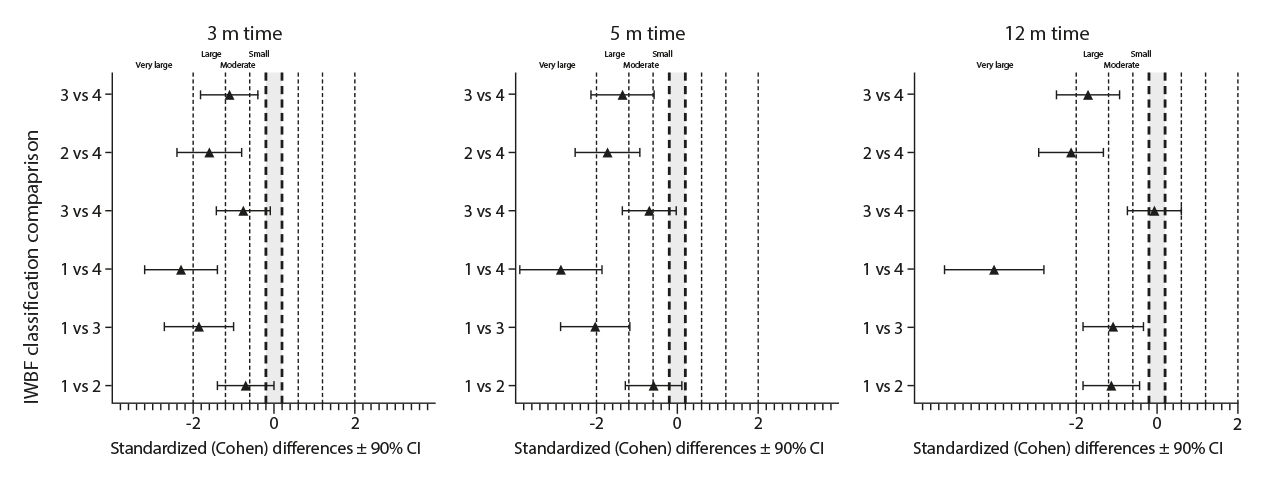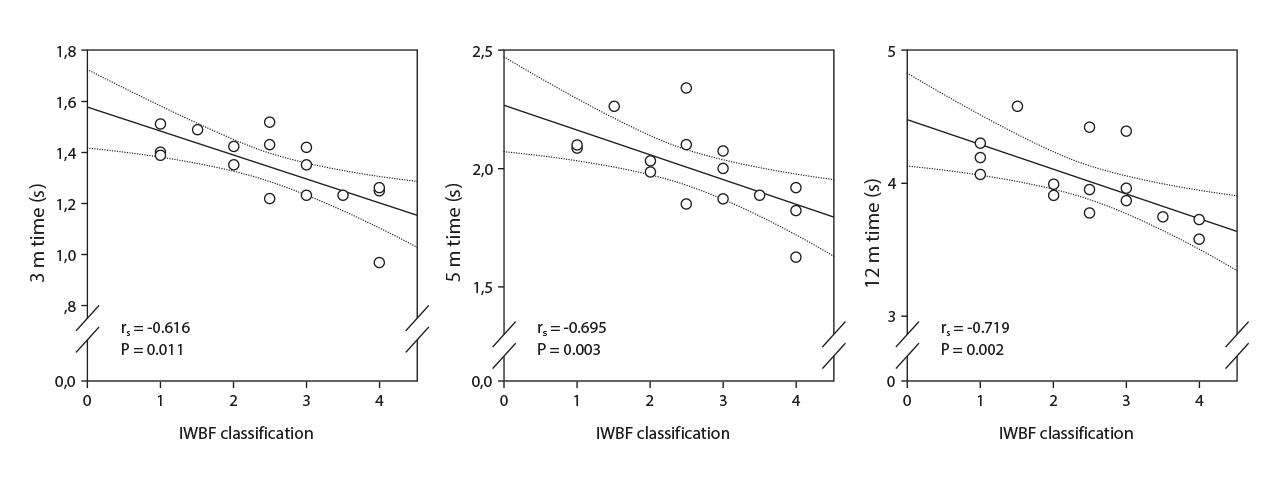Short Distance Sprint Performance in Elite Wheelchair Basketball Women Players: Influence of Functional Classification
*Correspondència: Gerard Carmona gercd1@gmail.com
Citació
García Fresneda, A., & Carmona, G. (2021). Short Distance Sprint Performance in Elite Wheelchair Basketball Women Players: Influence of Functional Classification. Apunts. Educación Física y Deportes, 144, 75-80 https://doi.org/10.5672/apunts.2014-0983.es.(2021/2).144.09
Abstract
The aim of this study was to analyse the short-distance sprint performance (SDSP) differences between functional International Wheelchair Basketball Federation (IWBF) classes in elite wheelchair basketball (WB) women players. Additionally, the association between WB experience and the IWBF functional classification score and SDSP was assessed. Sixteen WB women players belonging to the Spanish national WB team were grouped according to the functional IWBF classes: group 1 (class 1 and 1.5), group 2 (class 2 and 2.5), group 3 (class 3 and 3.5) and group 4 (class 4 and 4.5). Each participant completed 2 sets of 12-m wheeling sprints at maximum speed, and split times at 3, 5 and 12 m were recorded. Major significant differences were observed in SDSP between groups 1 and 4 (p <.05; effect size [ES] range: -2.27 – 4.02) and, while not significant, a clear trend in which the higher the functional IWBF classification the higher the SDSP was observed. Moreover, we found a significant strong association between the functional IWBF classification individual score and the SDSP (p < .05; rs range: 0.61 – 0.71). The SDSP test (split times at 3, 5 and 12 m) would therefore seem to be sufficiently sensitive to reflect the level of functional ability in elite WB women.
Introduction
There are five major functional International Wheelchair Basketball Federation (IWBF) classes in wheelchair basketball (WB)t: 1.0, 2.0, 3.0, 4.0 and 4.5 (IWBF Player Classification Commision, 2014). Although trunk, lower limb and upper limb function are important for determining player class, trunk movement and stability play a major role in determining the classification (Tachibana et al., 2019; Y. C. Vanlandewijck et al., 2011). Although there is no consensus, a higher class would appear to denote a higher level of functional abilities on the court (Marszałek et al., 2019; Y. C. Vanlandewijck et al., 2004). In this regard, a class 1.0 player presents a low degree of voluntary control in any plane, relying on their arms for support in all plane movements (Tachibana et al., 2019). On the contrary, a class 4.5 player presents mobility in all planes (Tachibana et al., 2019). In order to preserve fair play in competition, the sum of the points of the five players on the court cannot be higher than 14 (IWBF Executive Council, 2018) and each player’s functional class is evaluated by the practice and game observation during matches.
Although WB is probably one of the most popular sports for the disabled (Gil-Agudo et al., 2010), the evidence base supporting performance is still insufficient, particularly when compared to able-bodied sport (Paulson & Goosey-Tolfrey, 2017). Moreover, little is known about the players’ physical condition (Paulson & Goosey-Tolfrey, 2017). Previous studies have shown that WB match-play is characterized by high-intensity intermittent efforts (Coutts, 1992; Paulson & Goosey-Tolfrey, 2017), where accelerative wheeling sprint capacity, from a standstill (Ferro et al., 2016) and over short distances (driving forward from 3 to 12 m), might play an important role in game performance (De Witte et al., 2017). Twenty-metre field-based sprint tests have been used to assess WB women players’ sprint capacity according to their functional classification level (Molik et al., 2013; Tachibana et al., 2019), although only the study by Molik et al. (2013) also recorded sprint performance over a short distance (5 m), which might be much more related to specific WB competitive needs (De Witte et al., 2017). However, in that study, the participants were divided into two functional groups only (1.0–2.5 group and 3.0–4.5 group). Therefore, the relationship between the functional IWBF classification level and short-distance sprint performance (SDSP) remains unclear.
To the best of our knowledge, no studies have analysed the SDSP (i.e., 3, 5 and 12 m) in elite WB women. Moreover, there is a lack of evidence about differences in wheeling SDSP between IWBF functional class groups. Therefore, this study set out to analyse the SDSP differences between functional classification level in elite WB women. In addition, the association between WB experience and IWBF functional classification score with SDSP was assessed.
Methodology
Sixteen WB women players belonging to the Spanish national WB team participated in this study (Table 1). All the participants belonged to the Spanish Sports Federation for People with Physical Disabilities (FEDDF) and were classified in accordance with the IWBF Classification Committee (Table 1). Both are requisites for participating in official events for people in the physical disabilities’ category. Players were subsequently classified as follows: group 1 (class 1 and 1.5), group 2 (class 2 and 2.5), group 3 (class 3 and 3.5) and group 4 (class 4 and 4.5). The institutional research ethics committee of the Catalan Sports Council (No. 01_2017_CEICGC) approved this study. Prior to involvement in the investigation, all participants gave their written informed consent after a detailed written and oral explanation of the potential risks and benefits of participating in this study, as provided for in the Declaration of Helsinki (2013).
Each participant completed 2 sets of 12-m wheeling sprints at maximum speed, with a 5-minute rest (1 minute of active recovery and 4 minutes of passive recovery) between sets (García-Fresneda et al., 2019). The best attempt was recorded for further analyses. The participants were placed at 0.5 m from the starting point and began when they felt ready. Time was recorded using photocell gates (Microgate, Polifemo Radio Ligth®, Bolzano, Italy) with an accuracy of±0.001 s (Yanci et al., 2015). The timer was activated automati¬cally as the players passed the first timing gate at the 0.0-m mark and split times were then recorded at 3, 5 and 12 m. The 12-m sprint test has previously presented a very high reliability measured with radar in male Rugby wheelchair players (intraclass correlation coefficient [ICC] range = .97–.99) (García-Fresneda et al., 2019) and measured with photocells in WB men (coefficient of variation [CV] of 1.41% at 5 m) (Yanci et al., 2015).
Values are presented as mean ± SD. Data analysis was performed using IBM SPSS v20.0 (IBM Corp., Armonk, NY, USA). The data were screened for normality of distribution (Shapiro-Wilk). Homogeneity of variance was examined by Levene’s test. One-way analyses of variance (ANOVA) were used to evaluate differences in normally-distributed dependent variables across IWBF classification groups. In the event of a difference, Bonferroni post hoc tests were used to identify any localized effects. Magnitudes of difference were classed as trivial (<0.2), small (>0.2–0.6), moderate (>0.6–1.2), large (> 1.2–2.0) and very large (> 2.0–4.0) (Batterham & Hopkins, 2006). To analyze the association between ‘WB experience’ and ‘IWBF functional classification score’ with SDSP, Pearson’s correlation coefficient or Spearman’s rank correlation coefficient were used depending on the variable distribution, with thresholds of: .40– .59, moderate; .60–.79, strong; .80–1, very strong. Alpha was set at p <.05.
Results
Regarding the WB players’ characteristics, significant differences were only found in WB years of experience (see Table 1).

Table 1
Wheelchair basketball player characteristics. Results are in means ± SD.
Very large significant differences between groups 1 and 4 were found in all sprint distances measured (time at 3, 5 and 12 m) (Table 2) (Figure 1). While not significant, important meaningful differences were also found between groups 1 and 3 in sprint performance (ES=-1.83, large [90% CI: -3.21–0.45], ES = -2.04, very large [90% CI:-3.47–0.61], and ES = -1.13, moderate [90% CI:-2.38–0.12] for 3, 5 and 12 m times, respectively) (Figure 1). Large to very large meaningful differences were also found between groups 2 and 4 in sprint performance (ES=-1.61, large [90% CI: -2.87–0.34], ES=-1.63, large [90% CI:-2.89–0.36], and ES=-2.15, very large [90% CI:-3.53–0.77] for the 3, 5 and 12 m times, respectively). (Figure 1).

Table 2
Short-Distance Sprint Performance.


While training experience did not show any correlation with sprint performance, the functional IWBF classification score was strongly (Spearman’s rank correlation coefficient range: .61–.71) and significantly (p <.05) correlated with split times used to assess wheeling sprint performance (Figure 2).
Conclusions
The main contribution of this study is the characterization of the SDSP profile in elite WB women players, taking the influence of the functional IWBF classification groups into account. In this regard, very large significant differences were observed in SDSP between groups 1 and 4. Moreover, a significant strong association was found between the functional IWBF classification individual score and the SDSP.
Short-distance sprint performance: differences between groups
The results from this study showed a clear trend in which the higher the functional IWBF classification the higher the SDSP. Although, statistically significant, very large differences were only observed in SDSP between groups 1 and 4, small to moderate, and moderate to large meaningful differences were observed between groups 1 and 2, and 1 and 3, respectively. In this regard, our results are in line with the only previous study that has analyzed 5-m sprint performance in elite WB women players, taking functional IWBF classification (Molik et al., 2013) into account. Those authors found significant differences in 5-m sprint times between category A (class 1 to 2.5) and B (class 3 to 4.5) (2.2±0.1 and 2.0±0.2 s, respectively, p =.03). Moreover, significant differences between functional groups 1 and 4 in 20-m sprint performance have also been reported in the literature and no significant differences between adjacent groups (i.e., between groups 1 and 2, groups 2 and 3, and groups 3 and 4) (Tachibana et al., 2019), as in the case of our study. The differences between functional groups in sprint performance have mostly been accounted for in the literature by the influence of WB (or wheelchair) experience (Molik et al., 2013; Tachibana et al., 2019). While WB experience might play a role in the superior sprint performance exhibited by group 4 (particularly if compared to group 1), the present results would seem to indicate that the higher level of functionality might be much more decisive, since no differences were observed between groups 1 and 3 in WB experience, although large differences were observed in SDSP, especially at 3 and 5 m. This notion is also supported by the fact that while no differences were observed between groups 2 and 4 in WB experience, large to very large SDSP differences were obtained. Therefore, while the role of WB experience in these differences might be not ruled out, functionality might seem to play a major role in SDSP. The larger range of action and the higher trunk control of the functional classification group 4 (Vanlandewijck et al., 2001) might be related to a greater wheeling propulsion capacity. These functional advantages could explain the differences observed in SDSP between groups.
IWBF classification and sprint performance association
Contrary to previous reports in 5-m sprint measures, where no association was found between sprint performance and functional IWBF classification (#11
), in this study, significant strong correlations were found between SDSP and the functional IWBF classification individual score. Previous findings in WB men players (Gil et al., 2015; Yanci et al., 2015) indicate that sprinting abilities were more influenced by WB (or wheelchair) experience rather than by the functional classification. However, we did not find any statistical association between SDSP and WB training experience. Thus, our correlational results reinforce the notion that while training status and technical experience were likely to contribute to SDSP (especially because of the very large significant differences in WB training experience between groups 1 and 4), functionality seemed to play a more important role, confirming that the functional classification groups of women wheelchair basketball players is an accurate representation of their level of functional ability (Vanlandewijck et al., 2004).
In conclusion, a clear trend in which the higher the functional IWBF classification the higher the SDSP was obtained in elite WB women. The SDSP test (split times at 3, 5 and 12 m) would therefore appear to be sufficiently sensitive to reflect the level of functional ability in elite WB women players.
Acknowledgements
We gratefully acknowledge the players and the coaching staff of the national WB team for facilitating data collection, and the support of FC Barcelona Innovation Hub.
Referències
[1] Batterham, A. M., & Hopkins, W. G. (2006). Making meaningful inferences about magnitudes. International Journal of Sports Physiology and Performance, 1(1), 50–57. doi.org/10.1123/ijspp.1.1.50
[2] Coutts, K. D. (1992). Dynamics of wheelchair basketball. Med Sci Sports Exerc, 24(2), 231–234. doi.org/10.1249/00005768-199202000-00012
[3] De Witte, A. M. H., Hoozemans, M. J. M., Berger, M. A. M., Van der Slikker, R. M. A., Van der Woude, L. H. V., & Veeger, D. (H. E. J. (2017). Development, reliability, and construct validity of a field-based wheelchair mobility performance test. Journal of Sports Sciences, 0414(January). doi.org/10.1080/02640414.2016.1276613
[4] Ferro, A., Villacieros, J., & Pérez-Tejero, J. (2016). Sprint Performance of Elite Wheelchair Basketball Players: Applicability of a Laser System for Describing the Velocity Curve. Adapted Physcial Activity Quarterly, 33(4), 358–373. doi.org/10.1123/APAQ.2015-0067
[5] García-Fresneda, A., Carmona, G., Padullés, X., Nuell, S., Padullés, J. M., Cadefau, J. A., & Iturricastillo, A. (2019). Initial Maximum Push-Rim Propulsion and Sprint Performance in Elite Wheelchair Rugby Players. Journal of Strength and Conditioning Research, 33(3), 857–865. doi.org/10.1519/JSC.0000000000003015
[6] Gil-Agudo, A., Del Ama-Espinosa, A., & Crespo-Ruiz, B. (2010). Wheelchair Basketball Quantification. Physical Medicine and Rehabilitation Clinics of North America, 21(1), 141–156. doi.org/10.1016/j.pmr.2009.07.002
[7] Gil, S. M., Yanci, J., Otero, M., Olasagasti, J., Badiola, A., Bidaurrazaga-Letona, I., Iturricastillo, A., & Granados, C. (2015). The Functional Classification and Field Test Performance in Wheelchair Basketball Players. Journal of Human Kinetics, 46(1), 219–230. doi.org/10.1515/hukin-2015-0050
[8] IWBF Executive Council. (2018). Official Wheelchair Basketball Rules. 1–123. iwbf.org/wp-content/uploads/2019/03/2018_IWBF_rules-Ver-2_Final.pdf
[9] IWBF Player Classification Commision. (2014). Official Player Classification Manual. International Wheelchair Basketball Federation, 6, 1–29. www.wheelchairbasketball.ca/uploadedFiles/Members/Classifiers/Policies_and_Procedures/CLASSIFICATION%20MANUAL%202014-2018%20ENGLISH%20FINAL.pdf
[10] Marszałek, J., Kosmol, A., Morgulec-Adamowicz, N., Mróz, A., Gryko, K., Klavina, A., Skucas, K., Navia, J. A., & Molik, B. (2019). Laboratory and non-laboratory assessment of anaerobic performance of elite male wheelchair basketball athletes. Frontiers in Psychology, 10(MAR), 1–10. doi.org/10.3389/fpsyg.2019.00514
[11] Molik, B., Laskin, J. J., Kosmol, A., Marszałek, J., Morgulec-Adamowicz, N., & Frick, T. (2013). Relationships between anaerobic performance, field tests, and functional level of elite female wheelchair basketball athletes. Human Movement, 14(4), 366–371. doi.org/10.2478/humo-2013-0045
[12] Paulson, T., & Goosey-Tolfrey, V. (2017). Current perspectives on profiling and enhancing wheelchair court sport performance. In International Journal of Sports Physiology and Performance (Vol. 12, Issue 3, pp. 275–286). Human Kinetics Publishers Inc. doi.org/10.1123/ijspp.2016-0231
[13] Tachibana, K., Mutsuzaki, H., Shimizu, Y., Doi, T., Hotta, K., & Wadano, Y. (2019). Influence of Functional Classification on Skill Tests in Elite Female Wheelchair Basketball Athletes. Medicina, 55(11), 740. doi.org/10.3390/medicina55110740
[14] Vanlandewijck, Y. C., Evaggelinou, C., Daly, D. J., Verellen, J., Van Houtte, S., Aspeslagh, V., Hendrickx, R., Piessens, T., & Zwakhoven, B. (2004). The relationship between functional potential and field performance in elite female wheelchair basketball players. Journal of Sports Sciences, 22(7), 668–675. doi.org/10.1080/02640410310001655750
[15] Vanlandewijck, Y. C., Verellen, J., Beckman, E., Connick, M., & Tweedy, S. M. (2011). Trunk strength effect on track wheelchair start: Implications for classification. Medicine and Science in Sports and Exercise, 43(12), 2344–2351. doi.org/10.1249/MSS.0b013e318223af14
[16] Vanlandewijck, Y. C., Theisen, D., & Daly, D. (2001). Wheelchair propulsion biomechanics: implications for wheelchair sports. Sports Medicine, 31(5), 339–367. doi.org/10.2165/00007256-200131050-00005
[17] Yanci, J., Granados, C., Otero, M., Badiola, A., Olasagasti, J., Bidaurrazaga-Letona, I., Iturricastillo, A., & Gil, S. M. (2015). Sprint, agility, strength and endurance capacity in wheelchair basketball players. Biology of Sport, 32(1), 71–78. doi.org/10.5604/20831862.1127285
ISSN: 2014-0983
Rebut: 5 de junio de 2020
Acceptat: 27 de noviembre de 2020
Publicat: 1 de abril de 2021
Editat per: © Generalitat de Catalunya Departament de la Presidència Institut Nacional d’Educació Física de Catalunya (INEFC)
© Copyright Generalitat de Catalunya (INEFC). Aquest article està disponible a la url https://www.revista-apunts.com/. Aquest treball està publicat sota una llicència Internacional de Creative Commons Reconeixement 4.0. Les imatges o qualsevol altre material de tercers d’aquest article estan incloses a la llicència Creative Commons de l’article, tret que s’indiqui el contrari a la línia de crèdit; si el material no s’inclou sota la llicència Creative Commons, els usuaris hauran d’obtenir el permís del titular de la llicència per reproduir el material. Per veure una còpia d’aquesta llicència, visiteu https://creativecommons.org/licenses/by/4.0/deed.ca


